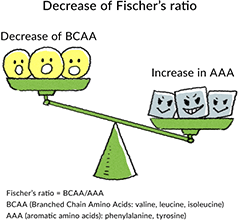Nutritional condition determines the prognosis of liver cirrhosis
The higher the patient's serum albumin level, the longer they will live
Previously, a diagnosis of liver cirrhosis came with a prognosis of about ten years and was the same as a death sentence. Recently, the prognosis for liver cirrhosis patients has improved considerably with progress seen in the treatment of various complications associated with cirrhosis, such as ascites, hepatic encephalopathy, etc. In addition, there have been reports on progress made in nutritional science in recent years indicating that continued nutritional therapy can lead to a better prognosis and quality of life. Among the nutritional factors identified, the level of serum albumin (the most abundant protein in blood plasma) has been discovered to be particularly crucial.
With liver cirrhosis, the serum albumin value (reference range: 3.8 to 5.1g/dL) decreases by an average of 0.15g/dL per year, and for the patients with a low serum albumin value (less than 3.5g/dL), the 5-year survival rate drops considerably.
In the past, patients were put on a high-protein diet to raise the serum albumin value to 3.5g/dL or more. However, when the disease progresses to the stage of decompensated cirrhosis, a high-protein diet and accompanying rise in the serum ammonia value can lead to the risk of developing hepatic encephalopathy. Thus, at that point a low-protein diet is ideal.
The following is an explanation of nutritional therapy to raise the level of serum albumin.
Abnormal nutrient metabolism in liver cirrhosis

Liver cirrhosis is a condition in which the liver never has enough energy, since energy consumption is high even when at rest and the liver's ability to use the sugars that are its energy source has declined. Moreover, analysis of amino acids in the blood of liver cirrhosis patients shows that the ratio (Fischer's ratio) of branched-chain amino acids (BCAA: valine, leucine, and isoleucine) to aromatic amino acids (AAA: phenylalanine and tyrosine) decreases. In other words, an amino acid imbalance is seen in which BCAAs have decreased while AAAs have increased. BCAAs are metabolized in muscle, detoxify ammonia, and at the same time are an amino acid that can be readily used by the liver as a source of energy. Accordingly, maintaining the amino acid balance by consuming more BCAAs and less AAAs can offset the liver's energy insufficiency. This will enable the liver to produce more albumin, which will improve the prognosis of liver cirrhosis.
How to address an amino acid imbalance
In an ideal world, we would eat foods with a lot of BCAAs and few AAAs, but there are no such foods in the natural world. Thankfully, an amino acid imbalance can be addressed with a combination of BCAA-rich enteral nutrition (tube feeding) and a low protein diet.
Lack of carnitine
Recently, it has been found that some liver cirrhosis patients are deficient in carnitine. Carnitine is an amino acid derivative and can be obtained from foods, but it is also produced by the liver and kidneys. For this reason, carnitine tends to be deficient in people who are on a restricted diet for cirrhosis treatment, and those who have chronic kidney failure and are on dialysis, etc.
Carnitine is an indispensable substance that plays an essential role in converting fatty acids to energy. When the body does not have enough carnitine, sufficient muscle energy is not produced, and muscle symptoms such as muscle weakness, muscle pain, and cramps are more likely to occur. A serious carnitine deficiency causes life-threatening damage to the liver, brain, heart, kidney and various other organs, and can lead to coma due to low blood sugar, brain diseases due to an excess of ammonia in the blood, heart disease, or anemia, etc. Because of this, it is considered important to supplement carnitine to combat any chronic deficiency in liver cirrhosis patients.
Consult your doctor, pharmacist, or nutritionist about your daily intake of protein and calories.






